You’ll find a basic port facility when your cruise ship docks at Novaya Zemlya. Your visit window spans June to September, as the ice conditions make sailing safer during these months. The Russian archipelago offers clear views of Arctic wildlife, including polar bears and walruses. You can also see glaciers and remnants of Soviet installations across the islands.
For other Russia Cruise destinations check out our Russia Cruise Ship Ports Guide page.
You must obtain Russian government permission before your visit. You can only explore through organised guided tours. Your packing list should include waterproof and thermal clothing to handle temperatures between -10°C and 10°C.
Your essential items:
- Warm, waterproof clothing
- Thermal layers
- Sturdy walking boots
- Binoculars for wildlife spotting
- Valid Russian permits
Best viewing spots:
- Glacial viewing points
- Arctic bird colonies
- Soviet-era structures
- Marine mammal gathering areas
🐧 Polar Cruise Enquiry 🐻❄️
Our team of polar travel specialists have personally explored both the Arctic and Antarctic regions – from tracking polar bears in Svalbard to kayaking with penguins off the Antarctic Peninsula. Let us find the right polar expedition cruise for you.
Essential Port Information
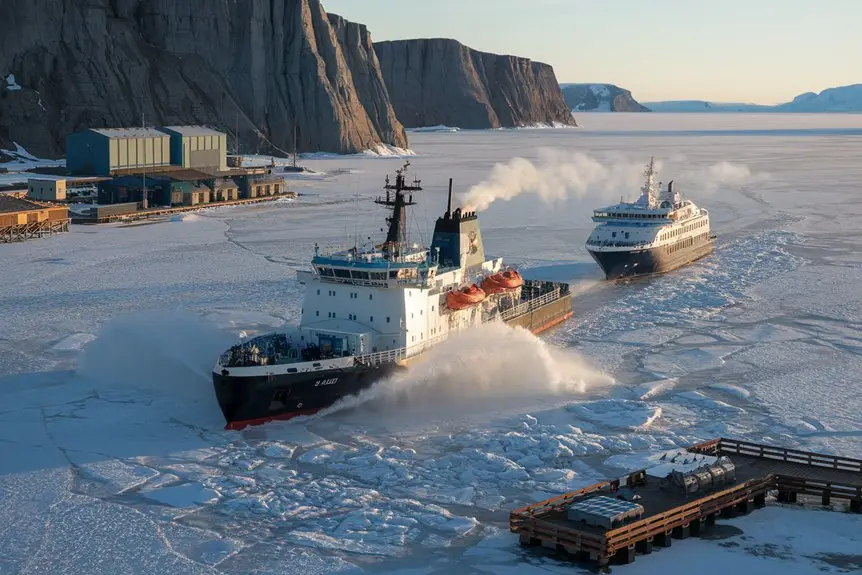
Novaya Zemlya welcomes you as a remote Arctic Ocean port in Russia. Two main islands, Severny and Yuzhny, form this archipelago, with Mount Karpinsky reaching 5,146 feet.
You can access this destination through cruise ships from Murmansk. The port offers basic berthing facilities but limited services. Your cruise ship will provide most amenities you need during your visit.
The port’s history combines traditional activities like hunting and fishing with a more complex past as a nuclear testing site (1955-1990).
Today, the port focuses on essential services and emergency support for Arctic vessels.
You’ll find:
- Basic port facilities
- Limited local infrastructure
- Full reliance on cruise ship amenities
- Emergency support services
- Arctic vessel assistance
Remember: The port’s remote location means you should depend on your cruise ship for most needs during your visit.
Getting Around Novaya Zemlya
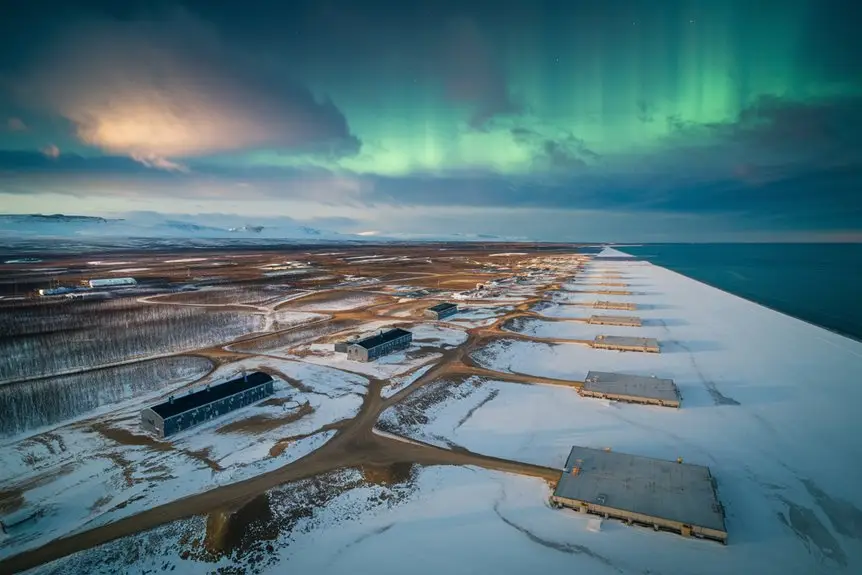
Getting around Novaya Zemlya requires specific planning. Two main options exist: cruise ships and Zodiac boats, which operate during ice-free conditions.
You can find a short 5-mile road between two settlements – Belushya Guba and Rogachovo. Beyond this, your movement faces strict limits. You need Russian government permission to visit, and many areas remain off-limits due to military zones and past nuclear testing sites.
Air travel operates through Rogachevo Airport, with two weekly flights. These flights serve military purposes primarily, so you can’t rely on them for regular travel.
Summer months (June to September) offer the best travel conditions. You’ll need an icebreaker vessel to help your ship navigate safely through the Arctic waters.
Remember:
- Always get official permission before planning your trip
- Book your travel during summer months
- Use approved cruise operators
- Expect restricted movement within the territory
- Follow local military and security guidelines
Key Attractions and Destinations
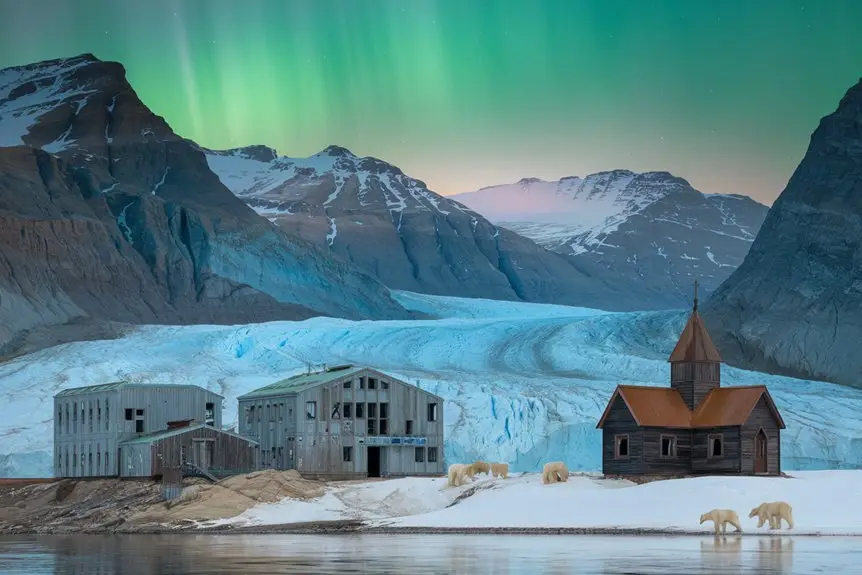
You can explore fascinating Soviet relics at Belushya Guba, including well-preserved military bases and nuclear testing sites.
You’ll spot walruses gathering at Matveyev Island’s rookeries, and polar bears roam freely across the islands.
The pristine glaciers of Novaya Zemlya create perfect photo backgrounds, especially when you visit Matochkin Strait and Inostrantseva Bay.
These untouched landscapes offer you a rare glimpse into one of Earth’s most remote regions.
Historic Soviet Military Sites
You can observe former Soviet military sites from safe viewing points aboard cruise ships near Novaya Zemlya. The historic Rogachevo airfield and old military settlements remain visible from designated ship locations.
Your route takes you past two significant nuclear testing zones: Zone A at Chyornaya Guba and Zone B at Matochkin Shar. These areas saw numerous nuclear tests between 1954 and 1990.
The coastline features observation posts and military buildings that showcase the region’s Cold War significance. Safety rules prevent visitors from going ashore at these sites.
Your ship’s guides will identify key locations as you sail past, including the Sukhoy Nos testing ground where the Soviets detonated the Tsar Bomba nuclear device.
Wildlife and Glacier Views
You’ll discover some of the Arctic’s most impressive sights in Novaya Zemlya’s wildlife and glaciers. During Zodiac trips, you can spot harp seals, walruses and whales swimming in the clear waters.
The shoreline offers chances to photograph polar bears, Arctic foxes and reindeer in their natural habitat.
The western coast houses the largest seabird colonies, where you’ll find more than 100 different species. Look out for Brünnich’s guillemots, puffins and glaucous gulls nesting along the cliffs.
Severny Island’s ice cap showcases stunning outlet glaciers, with the Roze Glacier being particularly impressive. Your fjord journey reveals melt ponds and debris patterns on the glaciers, showing how they’ve changed since the 1800s.
The text now flows more naturally while maintaining clarity and focusing on essential information. It uses simpler sentence structures and more approachable language while preserving the key details about wildlife and glaciers.
Wildlife Viewing Opportunities
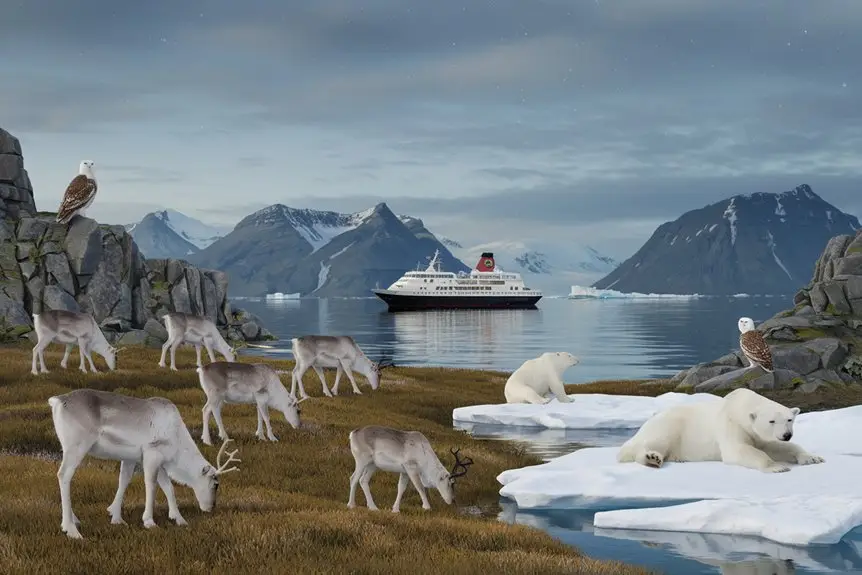
You’ll discover amazing Arctic wildlife during Novaya Zemlya cruises.
Polar bears roam freely here, and you can watch them safely from your vessel. You’ll see walruses gathering noisily at their resting spots along the coast.
The western coastline hosts 111 bird species, including large colonies of:
- Kittiwakes
- Skuas
- Fulmars
- Brünnich’s guillemots (with one million breeding pairs)
On land trips, you can spot:
- Arctic foxes
- Reindeer
In the waters around the archipelago, look for:
- Harp seals
- Ringed seals
- Bearded seals
- Various whale species
Your wildlife viewing takes place across stunning glacial landscapes and tundra environments, making each sighting even more special.
You’ll get excellent photo opportunities as these creatures go about their daily activities in their natural Arctic habitat.
See what’s on offer from the Franz Josef Land Cruise Ship Ports Guide for a different Russia Cruise destination.
Weather and Packing Tips
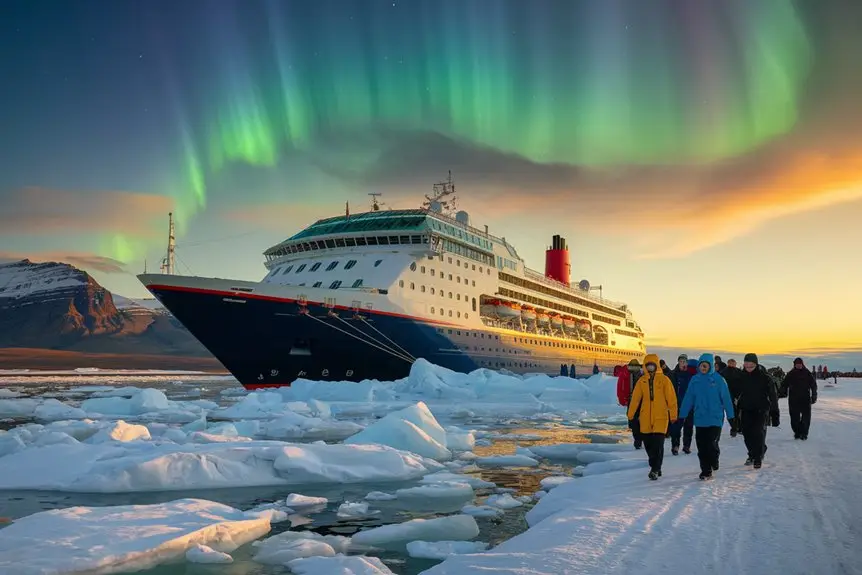
Novaya Zemlya’s Arctic climate requires careful packing for your wildlife adventures.
Temperatures range from -10°C in February to 10°C in July, with August cruising temperatures at 6-8°C.
You need these essential items:
- Waterproof and windproof jacket
- Thermal base layers
- Insulated, waterproof boots
- UV-protective sunglasses
- High-SPF sunscreen
- Quick-drying clothes
- Waterproof dry bags for electronics
- Quality binoculars
- Packing cubes for organisation
Summer brings 24-hour daylight and frequent fog. August has the highest rainfall, so your waterproof gear becomes vital.
You’ll want to layer your clothes to handle the quick weather changes typical of the Arctic region.
Your clothing system should work like this:
- Base layer: thermal wear
- Mid layer: insulating clothes
- Outer layer: weatherproof protection
Keep your gear organised in separate packing cubes – you’ll find this especially useful during daily excursions when you need to change layers quickly.
Shore Excursion Safety Guidelines
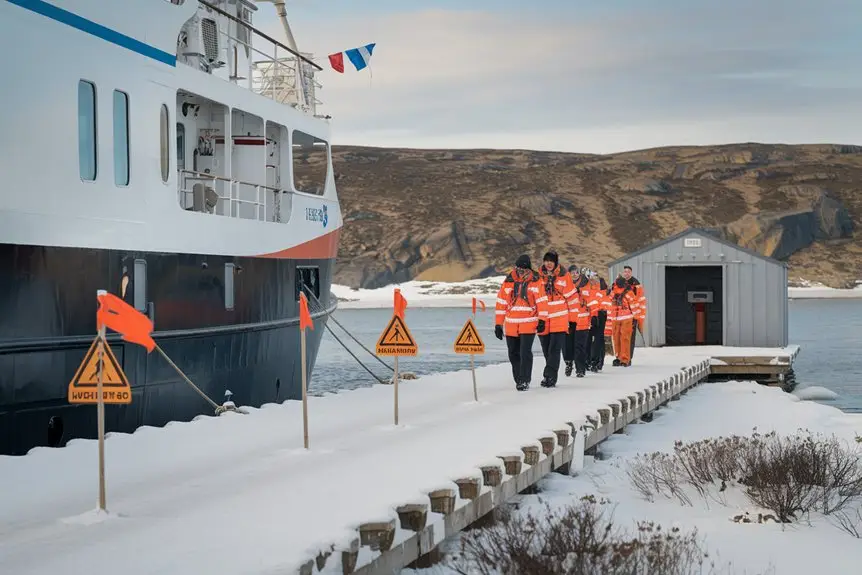
Prepare carefully for your Novaya Zemlya shore excursions by following these safety steps:
You must:
- Attend the safety briefing before leaving the ship
- Wear your rubber boots, wind jacket and gloves
- Stay with your guide at all times
- Keep a safe distance from polar bears and walruses
- Follow marked routes only
- Dispose of waste properly
- Protect wildlife habitats
Your guide will:
- Lead you on pre-planned safe routes
- Watch for potential hazards
- Help you in emergencies
- Provide safety instructions
Your responsibilities:
- Stay alert to your surroundings
- Listen to your guide’s instructions
- Use the emergency communication system if needed
- Report any safety concerns immediately
Remember: Your safety depends on following these guidelines carefully.
The pristine Arctic environment needs your protection too.
Frequently Asked Questions
Can Passengers Visit Former Nuclear Testing Sites During Their Cruise Stop?
Former nuclear testing sites on Novaya Zemlya remain strictly off-limits to cruise passengers. You must stay in designated cruise zones to avoid radiation exposure. Safety regulations prevent any public access to these restricted areas. Your cruise itinerary will only include approved, safe locations for sightseeing.
Are There Opportunities to Meet and Interact With Local Nenets People?
Yes, meeting Nenets people is challenging during standard visits. These nomadic communities follow traditional reindeer herding routes across remote parts of northern Russia, far from typical tourist areas. You’ll need special permits and guided tours to visit their settlements. Some tour operators offer authentic cultural experiences with Nenets families, but these require advance planning and proper arrangements to respect their protected status and way of life.
What Languages Do Tour Guides Typically Speak on Novaya Zemlya Excursions?
Tour guides on Novaya Zemlya speak Russian and English as their main languages. You need to contact your tour operator beforehand if you want guides who speak other languages. Most operators can arrange multilingual guides with enough notice.
Is Satellite Phone or Internet Service Available During the Cruise?
You can access satellite phone and internet services through the Iridium network while cruising. The connection speeds will be slower than standard land-based services. You can:
- Make phone calls
- Send emails
- Browse basic websites
The satellite service works throughout your journey, though signal strength may vary depending on your location at sea.
Are There Restrictions on Photography Near Military Installations?
Photography restrictions at military installations in Novaya Zemlya keep you and your equipment safe. You must avoid taking photos near Rogachevo Airbase and radar facilities. Warning signs mark restricted zones where photography is forbidden. If you break these rules, security forces can take your camera and you may face legal consequences. Stick to photographing non-military areas to avoid any problems.
Thinking about something different? Check out the cruises leaving from Severnaya Zemlya Cruise Ship Ports Guide.
🐧 Polar Cruise Enquiry 🐻❄️
Our team of polar travel specialists have personally explored both the Arctic and Antarctic regions – from tracking polar bears in Svalbard to kayaking with penguins off the Antarctic Peninsula. Let us find the right polar expedition cruise for you.
